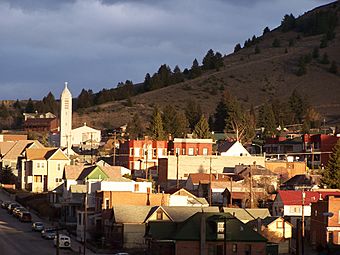Butte–Anaconda Historic District facts for kids
|
Butte–Anaconda Historic District
|
|
 |
|
| Lua error in Module:Location_map at line 420: attempt to index field 'wikibase' (a nil value). | |
| Location | Walkerville, Butte and Anaconda, Montana |
|---|---|
| Area | 15.2 square miles (39 km²) |
| Built | 1864 |
| NRHP reference No. | 66000438 |
Quick facts for kids Significant dates |
|
| Added to NRHP | October 15, 1966 (original) 2006 (expansion) |
| Designated NHLD | July 4, 1961 |
The Butte–Anaconda Historic District is a very important place in Montana, United States. It is known as a National Historic Landmark (NHL). This means it's a special spot recognized by the U.S. government for its history.
This district covers parts of three towns: Walkerville, Butte, and Anaconda. It has more historic buildings and sites than any other National Historic Landmark District in the United States.
It first became an NHL in 1961. Back then, it only included the city of Butte. Later, in 2006, the district got much bigger. It grew to include parts of Walkerville and Anaconda. It also added the railway line of the Butte, Anaconda and Pacific Railroad. The expanded district is about 9,774 acres (39 square kilometers). It has almost 6,000 properties that are important to history.
Other large historic areas like New York's Adirondack Park and Alaska's Cape Krusenstern Archeological District are bigger in size. However, they might have fewer historic buildings or sites than the Butte–Anaconda District.
Contents
Why This Place is Special
This historic district is important to the whole country for two main reasons. First, it played a huge role in producing copper for many years. Second, it was a key place where the labor union movement grew in the United States.
Copper Mining History
In the early 1900s, the mines in Butte produced a lot of copper. They supplied almost one-third of all the world's copper! Copper was a very important metal. It was needed for American factories and industries to grow and make new things.
Different Roles of the Towns
- Walkerville shows what early mining towns were like. You can still see how things looked in the late 1800s and early 1900s.
- Butte is a city where old mining equipment, like tall head frames, stands next to homes and businesses. It shows how industry and city life mixed.
- Anaconda was built as a "company town." This means a company created it mainly for its workers. Anaconda was where the copper ore from Butte's mines was melted down.
- The Butte, Anaconda and Pacific Railroad connects Butte and Anaconda. This railway is also a special part of the expanded historic district.
The Rise of Labor Unions
Butte was known as the "Gibraltar of Unionism." This means it was a very strong place for labor unions. A labor union is a group of workers who join together to protect their rights.
Key Moments in Union History
- Mine workers in Butte started one of the first unions in 1878.
- Members of the Butte union helped create bigger unions. These included the Western Federation of Miners and the Industrial Workers of the World. Later, they also helped form the Congress of Industrial Organizations (CIO).
- From 1914 to 1920, there were many disagreements between workers and companies in Butte. These events showed how companies and unions might act across the country.
- Important events during this time included the death of union leader Frank Little. There was also a serious event called the Anaconda Road Massacre.
- What happened in Butte also influenced politicians. One example is Burton K. Wheeler, who was a U.S. senator from Montana for a long time.
See also
 In Spanish: Distrito Histórico de Butte-Anaconda para niños
In Spanish: Distrito Histórico de Butte-Anaconda para niños

